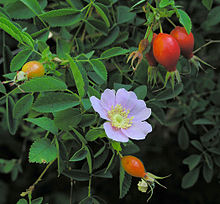| California wildrose | |
|---|---|

| |
| Scientific classification | |
| Kingdom: | Plantae |
| Clade: | Tracheophytes |
| Clade: | Angiosperms |
| Clade: | Eudicots |
| Clade: | Rosids |
| Order: | Rosales |
| Family: | Rosaceae |
| Genus: | Rosa |
| Species: | R. californica |
| Binomial name | |
| Rosa californica Cham. & Schldl. | |
Rosa californica, the California wildrose, or California rose, is a species of rose native to the U.S. states of California and Oregon and the northern part of Baja California, Mexico. The plant is native to chaparral and woodlands and the Sierra Nevada foothills, and can survive drought, though it grows most abundantly in moist soils near water sources.
This thorny, flowering, fruit-bearing shrub is also deciduous, and grows vertically up to six feet tall. The meaning of its name is twofold; Rosa, that it resembles or is composed of roses, and californica, that it originates from California.
Description

Rosa californica is a bush or thicket-forming shrub with prickly, curving stems. The fragrant flowers may grow singly or in inflorescences of several blooms. Each rose is open-faced and generally flat, with five petals in any shade of pink from almost white to deep magenta. The five smooth petals and sepals have a bowl-like bloom, semi-inferior ovaries, and compound veiny and hairy leaves. R. californica also bears fruit called "rose hips," which contain yellow seeds.
Distribution, habitat, and adaptations
Rosa californica is a common plant native to California. It is primarily found in elevations of below 6,000 feet. While most common in moist regions like river banks, the plant can also adapt to various soil textures, develop drought resistance, and has common-pest and disease resistance.
Competition
Rosa californica competes with other vegetation in moist environments because of its lateral spreading rhizomes (horizontally-spreading underground roots) and above-ground, thorny stems. Moreover, the wildroses' stems and shoots can be cut, but will regrow from submerged rhizomes. Thus, R. californica may develop thickets and overwhelm "desirable vegetation" under improper management. However, it does not pose a foreseeable environmental concern.
Cultivation

Rosa californica is used in California native gardens and habitat gardens, forming colonies, and attracting wildlife with the bright rose hips in autumn. Hard, dry internal seeds can be extracted by hand from mature, bright red hips. The wildrose can also be propagated with stem or rhizome cuttings.
Uses
Rosa californica is readily acclimated. Its natural propagation helps restore damp areas. Subterranean stems stabilize the surrounding earth. Thorny thickets offer ground cover, shelter, and even nests for organisms.
R. californica's open flowers and nectar attract insects and pollinators. Its lengthened spring to fall blooming period offers food for local bees. R. californica's fruits also persist on thickets through the forage-scarce winter, serving as food for bugs, birds, and hoofed mammals like deer and elk.
The wildroses' hips are related to the Rosaceae family's apricots, apples, and roses. They are fragrant, edible, and look and taste like "small apples." Some indigenous California tribes eat R. californica's hips raw and use the stems and fibers for crafts like coiled baskets, jewelry, and decoration. Other tribes leverage the roses' medicinal properties. They used a mix of rose petals, leaves, and/or rose "hips" in drinks or as medicine to relieve skin and general inflammation, pain, and illness (including fever, stomach pains, and sores).
The rose hips were used during World War II for their high vitamin content. They are dried for tea, or for use in jellies and sauces. The Cahuilla eat the rose buds raw or soaked them in water for drinking. A tea was also made from the roots, and used for colds. Because the rose hips remain on the plant throughout the winter, they provide food for wildlife during times when little forage is available.
See also
- California chaparral and woodlands - (ecoregion)
- California montane chaparral and woodlands - (sub-ecoregion)
- California interior chaparral and woodlands - (sub-ecoregion)
References
- NRCS. "Rosa californica". PLANTS Database. United States Department of Agriculture (USDA). Retrieved 23 October 2015.
- ^ "R. californica Taxon page". Jepson Herbarium, University of California, Berkeley. Retrieved 2014-08-12.
- "Rosa californica Plants Profile". USDA. Retrieved 2014-08-12.
- ^ "California Wild Rose". Golden Gate National Parks Conservancy. 2018-09-04. Retrieved 2022-10-12.
- ^ "California (Wild) Rose, Rosa californica". nathistoc.bio.uci.edu. Retrieved 2022-10-13.
- ^ Smither-Kopperl, M. L. (2021). Plant Guide for California wildrose (Rosa californica). United States Department of Agriculture, Natural Resources Conservation Service. Retrieved 2022-10-08.
- ^ California Phenology Project: Species profile for California Wildrose (Rosa californica). USA National Phenology Network, National Park Service, UCSB. Retrieved 2022-10-08.
- Keator, Glenn; Middlebrook, Alrie (2007). Designing California native gardens: the plant community approach to artful, ecologial gardens. University of California Press. p. 290. ISBN 978-0-520-25110-6.
- Clarke, Charlotte Bringle (1977). Edible and Useful Plants of California (California Natural History Guides (Paperback)). Berkeley: University of California Press. p. 81. ISBN 0-520-03267-5.
External links
| Taxon identifiers | |
|---|---|
| Rosa californica |
|
- Roses
- Flora of California
- Flora of Oregon
- Flora of Baja California
- Flora of the Klamath Mountains
- Flora of the Sierra Nevada (United States)
- Natural history of the California chaparral and woodlands
- Natural history of the California Coast Ranges
- Natural history of the Channel Islands of California
- Natural history of the Central Valley (California)
- Natural history of the Peninsular Ranges
- Natural history of the San Francisco Bay Area
- Natural history of the Santa Monica Mountains
- Natural history of the Transverse Ranges
- Garden plants of North America
- Bird food plants
- Drought-tolerant plants
- Plants used in Native American cuisine
- Plants described in 1827
- Plants used in traditional Native American medicine